16.3: The Electric Field
- Last updated
- Nov 7, 2023
- Save as PDF
- Page ID
- 89743
( \newcommand{\kernel}{\mathrm{null}\,}\)
We define the electric field vector, →E, in an analogous way as we defined the gravitational field vector, →g. By defining the gravitational field vector, say, at the surface of the Earth, we can easily calculate the gravitational force exerted by the Earth on any mass, m, without having to use Newton’s Universal Theory of Gravity. As you recall, we can define the gravitational field, →g(→r), at some position, →r, from a point mass, M, as the gravitational force per unit mass:
→g(→r)=−GMr2ˆr
where →r is a vector from the position of M to where we want to know the gravitational field. As a result, the force exerted on a “test mass”, m, located at position →r relative to mass M is given by:
→Fg=m→g=−GMmr2ˆr
which, of course, is the result from Newton’s Theory of Gravity. As you recall, we can define the gravitational field for any object that is not a point mass (e.g. the Earth), and use that field to find the force exerted by the Earth on any mass m, without having to re-calculate the gravitational field each time (which requires an integral or Gauss’ Law).
We proceed in an analogous was to define the “Electric field”, →E(→r), as the electric force per unit charge. If we have a point charge, Q, located at the origin of a coordinate system, then the electric field from that point charge, →E(→r), at some position, →r, relative to the origin is given by:
→E(→r)=kQr2ˆr
If we place a “test charge”, q, at position →r in space, it will experience a force given by:
→Fe=q→E=kQqr2ˆr
just as we find from Coulomb’s Law.
Exercise 16.3.1
A negative charge is placed at the origin of a coordinate system. At some point in space, the electric field from that charge
- points towards the origin.
- points away from the origin.
- Answer
- A.
In Example 16.2.2, we determined the electric force on charge q, exerted by two other charges Q1 and Q2. If we now changed the value of q and wanted to determine the force, we can use the electric field to simplify the process considerably. That is, we can determine the value of the electric field, →E, from Q1 and Q2 at the position of q, and then simply multiply that field vector by a charge q to obtain the force on that charge, without having to add force vectors.
Example 16.3.1
Two charges, \(Q_1=1\text{nC}\), and Q2=−2nC are held fixed at two corners of an equilateral triangle with sides of length a=1cm, with a coordinate system as shown in Figure 16.3.2. What is the electric field vector at the third corner of the triangle?
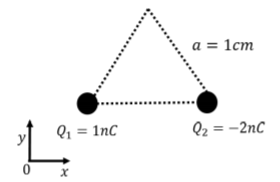
Solution
The net electric field at the third corner of the triangle will be the vector sum of the electric fields from charges Q1 and Q2. We thus need to determine the electric field vectors from each charge, and then add those two vectors to obtain the net electric field. The vectors are illustrated in Figure 16.3.2.
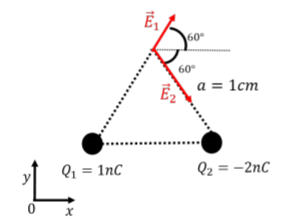
The electric field from charge Q1 has magnitude:
E1=|kQ1a2|=(9×109N⋅m2/C2)(1×10−9C)(0.01m)2=9×104N/C
and components:
→E1=E1cos(60∘)ˆx+E1sin(60∘)ˆy=(4.5×104N/C)ˆx+(7.8×104N/C)ˆy
Similarly, the electric field from Q2 has magnitude:
E2=|kQ2a2|=(9×109N⋅m2/C2)(2×10−9C)(0.01m)2=1.8×105N/C
and components:
→E2=E2cos(60∘)ˆx−E2sin(60∘)ˆy=(9.0×104N/C)ˆx−(1.6×105N/C)ˆy
Finally, we can add the two force vectors together to obtain the net force on q:
→Enet=→E1+→E2=(4.5×104N/C)ˆx+(7.8×104N/C)ˆy+(9.0×104N/C)ˆx−(1.6×105N/C)ˆy=(13.5×104N/C)ˆx−(8.2×104N/C)ˆy
which has a magnitude of 15.8×104N/C. By knowing the electric field at the empty corner of the triangle, we can now calculate the net electric force that would act on any charge placed in that location. For example, if we place a charge q=−1nC (as in Example 16.2.2), we can easily find the corresponding electric force:
→Fq=q→E=(−1nC)[(13.5×104N/C)ˆx−(8.2×104N/C)ˆy]=−(13.5×10−5N)ˆx+(8.2×10−5N)ˆy
as we found previously. Note that the force on q is in the opposite direction of the electric field vector. This is because q is negative. The electric field at some point in space thus points in the same direction as the force that a positive test charge would experience.
Discussion
In this example, we determined the net electric field by making use of the superposition principle; namely, that we can treat the electric fields from Q1 and Q2 independently, without needing to consider the fact that Q1 and Q2 exert forces on each other. By knowing the electric field at some position in space, we can easily calculate the force vector on any test charge, q, placed at that position. Furthermore, the sign of the charge q will determine in which direction the force will point (parallel to →E for a positive charge and anti-parallel to →E for a negative charge).
Exercise 16.3.2
The electric field inside of a conductor must be zero because...
- If there is an electric field, electrons will move (since it is a conductor) and arrange themselves so as to create an additional field that cancels the original field
- If there is an electric field, protons will move (since it is a conductor) and arrange themselves so as to create an additional field that cancels the original field
- Since electrons can move freely, they move so fast that the electric field is negligible.
- Electric fields cannot penetrate conducting materials.
- Answer
- A.
Visualizing the electric field
Generally, a “field” is something that has a different value at different positions in space. The pressure in a fluid under the presence of gravity is a field: the pressure is different at different heights in the fluid. Since pressure is a scalar quantity (a number), we call it a “scalar field”. The electric field is called a “vector field”, because it is a vector that is different at each position in space. One way to visualize the electric field is to draw arrows at different positions in space; the length of the arrow is then proportional to the strength of the electric field at that position, and the direction of the arrow then represents the direction of the electric field. The electric field for a point charge is shown using this method in Figure 16.3.3.
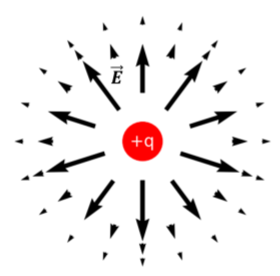
One disadvantage of visualizing a vector field with arrows is that the arrows take up space, and it can be challenging to visualize how the field changes magnitude and direction continuously through space. For this reason, one usually uses “field lines” to visualize a vector field. Field lines are continuous lines with the following properties:
- The direction of the vector field at some point in space is tangent to the field line at that point.
- Field lines have a direction to indicate the direction of the field vector along the tangent (as there are two possibilities, parallel and anti-parallel).
- The magnitude of the field is proportional to the density of field lines at that point. The more field lines near a location in space, the larger the magnitude of the field vector at that point.
An example of using field lines to represent a vector field in space is shown in Figure 16.3.4. The corresponding field vector is shown at two different positions in space (A and B). At both positions, the vector is tangent to the field line at that position in space and points in the direction of the little arrow drawn at the end of the field lines. The field vector at point A has a larger magnitude than the one at point B, since the field lines are more concentrated at point A than at point B (there are more field lines per unit area at that position in space, the field lines are closer together).
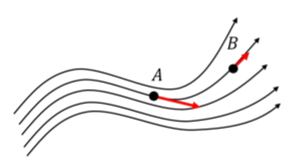
Exercise 16.3.3
It is possible for field lines to cross?
- Yes.
- No.
- Answer
-
B.
Because the electric field vector always points in the direction of the force that would be exerted on a positive charge, electric field lines will point out from a positive charge and into a negative charge. The electric field lines for a combination of positive and negative charges is illustrated in Figure 16.3.5.
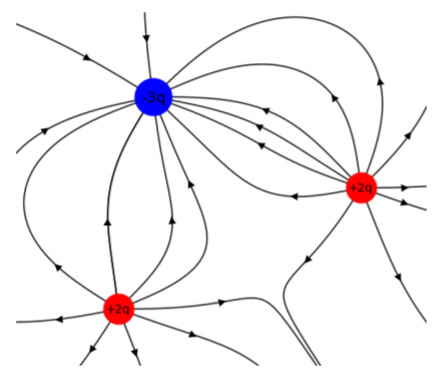
Electric field from a charge distribution
So far, we have only considered Coulomb’s Law for point charges (charges that are infinitely small and can be considered to exist at a single point in space). We can use the principle of superposition to determine the electric field from a charged extended/continuous object by modeling that object as being made of many point charges. The electric field from that object is then the sum of the electric field from the point charges that make up that object.
Consider a charged wire that is bent into a semi-circle of radius R, as in Figure 16.3.6. The wire carries a net positive electric charge, +Q, that is uniformly distributed along the length of the wire. We wish to determine the electric field vector at the center of the circle.
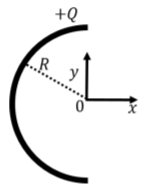
We start by choosing a very small section of wire and model that section of wire as a point charge with infinitesimal charge dq (as in Figure 16.3.7). A distance R from that point charge, the electric field from that point charge will have magnitude, dE, given by:
dE=kdqR2
The electric field vector, d→E, from the point charge dq is illustrated in Figure 16.3.7.
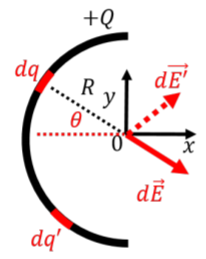
Using the coordinate system that is shown, we define θ as the angle made by the vector from the origin to the point charge dq and the x-axis. The electric field vector from dq is then given by:
d→E=dEcosθˆx−dEsinθˆy
The total electric field at the origin will be obtained by summing the electric fields from the different dq over the entire semi-circle:
→E=∫d→E=∫(dEcosθˆx−dEsinθˆy)=(∫dEcosθ)ˆx−(∫dEsinθ)ˆy∴Ex=∫dEcosθ∴Ey=−∫dEsinθ
We are thus left with two integrals to solve for the x and y components of the electric field, respectively. Before jumping into solving the integrals, it is useful to think about the symmetry of the problem. Specifically, consider a second point charge, dq′, located symmetrically about the x-axis from charge dq, as illustrated in Figure 16.3.7. The charge dq′ will create a small electric field d→E′ as illustrated. When we add together d→E and d→E′, the two y components will cancel, and only the x components will sum together. Similarly, for any dq that we choose, there will always be another dq′ such that when we sum together their respective electric fields, the y components will cancel. Thus, by symmetry, we can argue that the net y component of the electric field, Ey, must be identically zero. We thus only need to evaluate the x component of →E:
Ex=∫dEcosθ=∫kdqR2cosθ
In order to solve this integral, we need to consider which variables change for different choices of the point charge dq. In this case, the distance R is the same anywhere along the semi-circle, so only θ changes with different choices of dq, as k is a constant. We can express dq in terms of dθ and then use θ as the variable of integration (the variable that labels the different dq). dθ corresponds to a small change in the angle θ, and is the angle that is subtended by the charge dq. That is, the charge dq covers a small arc length, ds, of the semi-circle, which is related to dθ by:
ds=Rdθ
The total charge on the wire is given by Q, and the wire has a length πR (half the circumference of a circle). Since the charge is distributed uniformly on the wire, the charge per unit length of any piece of wire must be constant. In particular, dq divided by ds must be equal to Q divided by πR:
dqds=QπR∴dq=QπRds=Qπdθ
where in the last equality we used the relation ds=Rdθ. We now have all of the ingredients to solve the integral:
Ex=∫kdqR2cosθ=∫+π/2−π/2kQπR2cosθdθ=kQπR2∫+π/2−π/2cosθdθ=kQπR2[sinθ]+π/2−π/2=k2QπR2
The total electric field vector at the center of the circle is thus given by:
→E=k2QπR2ˆx
Note that if we had not realized that we did not need to solve the integral for the y component, we would still find that it is zero:
Ey=−kQπR2∫+π/2−π/2cosθdθ=−kQπR2[−cosθ]+π/2−π/2=0
In order to determine the electric field at some point from any continuous charge distribution, the procedure is generally the same:
- Make a good diagram.
- Choose a charge element dq.
- Draw the electric field element, d→E, at the point of interest.
- Write out the electric field element vector, d→E, in terms of dq and any other relevant variables.
- Think of symmetry: will any of the component of d→E sum to zero over all of the dq?
- Write the total electric field as the sum (integral) of the electric field elements.
- Identify which variables change as one varies the dq and choose an integration variable to express dq and everything else in terms of that variable and other constants.
- Do the sum (integral).
Example 16.3.2
A ring of radius R carries a total charge +Q. Determine the electric field a distance a from the center of the ring, along the axis of symmetry of the ring.
Solution
In order to determine the electric field, we carry out the procedure outlined above, and start by drawing a good diagram, as in Figure 16.3.8, showing: our coordinate system, our choice of dq, the electric field element vector d→E that corresponds to dq, and variables (r, θ) to specify the position of dq.
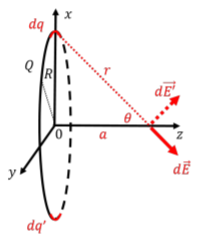
In this case, the figure is challenging to draw and visualize because of the three-dimensional nature of the problem. With the specific dq that we chose, the electric field element vector is given by:
d→E=−dEsinθˆx+0ˆy+dEcosθˆz
where d→E has magnitude:
dE=kdqr2
The x and z components of the total electric field will then be given by:
Ex=−∫dEsinθ=−∫kdqr2sinθEz=∫dEcosθ=∫kdqr2cosθ
In general, if we had chosen a dq that is not along one of the axes of the coordinate system, the electric field element vector would have components in all three directions. However, if we consider the symmetry of the ring, we can note that once we sum together all of the electric field elements, only the z components will survive. Indeed, we have shown in Figure 16.3.8 that for each dq, there will be a dq′ located on the opposite side of the ring that will create an electric field element that will cancel all but the z component of the field element from dq. We thus only need to consider the z components of the electric field elements when determining the total electric field:
→E=Ezˆz
We now have to evaluate the integral for the z component of the electric field:
Ez=∫kdqr2cosθ
and determine which quantities change as we move dq around the ring. In this case, both r2 and cosθ are the same for all elements on the ring, and the integral is trivial:
Ez=k1r2cosθ∫dq=kQr2cosθ=kQa(R2+a2)32
where the integral ∫dq simply means “sum all of the charges dq together”, which is equal to Q, the total charge on the ring. In the last equality, we replaced cosθ with the variables a and R that are provided in the question.
Example 16.3.3
You have rubbed a glass rod with a silk cloth such that the glass rod has acquired a positive charge. The rod has a length, L, a negligible cross-section, and has acquired a total positive charge, +Q, that is uniformly distributed along the length of the rod. What is the electric field a distance R from the center of the rod?
Solution
In order to determine the electric field, we carry out the procedure outlined above, and start by drawing a good diagram, as in Figure 16.3.9, showing: our coordinate system, our choice of dq at a distance y above the center of the rod, the electric field element vector d→E that corresponds to dq, and variables (y, r, θ) to specify the position of dq.
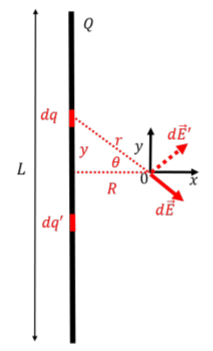
We define the origin to be located at the point where we want to determine the electric field, and the angle θ to be the angle between the horizontal and the position vector of dq. We can write the electric field element vector as:
d→E=dEcosθˆx−dEsinθˆy
where d→E has magnitude:
dE=kdqr2
The x and y components of the total electric field will then be given by:
Ex=∫dEcosθ=∫kdqr2cosθEy=−∫dEsinθ=−∫kdqr2sinθ
Again, before proceeding with the integrals, we consider symmetry. Specifically, if we consider a charge dq′ located symmetrically about the x axis from dq (as illustrated in Figure 16.3.9), we see that the y component of the electric field element d→E′ that it creates will cancel the y component of d→E. For each choice of dq, there will exist a corresponding choice dq′ which will result in the y component of the net electric field being zero. We thus only need to evaluate the x component of the total electric field:
→E=Exˆx=(∫kdqr2cosθ)ˆx
Within the integrand, both r and θ will change as we sum over the different charges dq along the rod. A straightforward option to write the integral is to use y as the integration constant, and to write dq, r, and cosθ in terms of y. The charge dq covers an infinitesimal length of the rod, dy. Since the rod is uniformly charged, the charge per unit length must be the same over a small length dy as it is over the whole length of the rod:
dqdy=QL∴dq=QLdy
It is often useful to introduce a constant charge per unit length, λ=QL, so that we can write the charge dq as:
dq=λdy
We can also express r2 and cosθ in terms of y (and R, which is constant):
r2=y2+R2cosθ=Rr=R√y2+R2
Finally, we can combine this all into an integral that we can evaluate:
Ex=∫kdqr2cosθ=k∫L/2−L/2λ1y2+R2R√y2+R2dy=kRλ∫L/2−L/21(y2+R2)32dy=kRλ[yR2√y2+R2]L/2−L/2∴Ex=kλRL√(L2)2+R2
If the rod were infinitely long (or very long compared to the distance R), the electric field becomes:
lim
By using the charge per unit length, \lambda, we were able to easily generalize our result to that expected for an infinitely long rod with uniform charge density.
Solving the integral above in terms of the integration variable y is difficult without some knowledge of integrals. For this specific integral, the easiest method to use from calculus is “trig substitution”. We show below how we can arrive at a much easier integral if we had instead chosen the angle \theta as the integration variable instead of y, and we will see that this is a physical illustration of the “trig substitution method” from calculus!
We go back to step 7 in our procedure and choose \theta (instead of y) as the integration variable for the integral:
\begin{aligned} E_x &=\int k\frac{dq}{r^2}\cos\theta\\[4pt]\end{aligned}
That is, we need to express 1/r^2 and dq in terms of \theta. Referring to Figure \PageIndex{9}, we have:
\begin{aligned} r &= \frac{R}{\cos\theta}\\[4pt] \therefore \frac{1}{r^2}&=\frac{\cos^2\theta}{R^2}\\[4pt] y &= R\tan\theta\\[4pt] \therefore dy &= \frac{dy}{d\theta}d\theta=\frac{R}{\cos^2\theta}d\theta\\[4pt] \therefore dq &= \lambda dy =\lambda\frac{R}{\cos^2\theta}d\theta\end{aligned}
The only difficulty is in determining the angle d\theta subtended by dq, which was determined above by first relating dy and d\theta. With these substitutions, the integral becomes trivial:
\begin{aligned} E_x &=\int k\frac{dq}{r^2}\cos\theta\\[4pt] &=k\int_{-\theta_0}^{\theta_0} \lambda\frac{R}{\cos^2\theta} \frac{\cos^2\theta}{R^2} \cos\theta d\theta=\frac{k\lambda}{R}\int_{-\theta_0}^{\theta_0}\cos\theta d\theta=\frac{k\lambda}{R}\left[\sin\theta \right]_{-\theta_0}^{\theta_0}\\[4pt] &=\frac{2k\lambda}{R}\sin\theta_0\end{aligned}
where \theta_0 is the angle subtended by half of the rod. Referring to Figure \PageIndex{9}, we can easily see that:
\begin{aligned} \sin\theta_0=\frac{L/2}{\sqrt{\left(\frac{L}{2}\right)^2+R^2}}\end{aligned}
So that the total electric field is given by:
\begin{aligned} E_x &=\frac{2k\lambda}{R}\sin\theta_0=\frac{k\lambda}{R}\frac{L}{\sqrt{\left(\frac{L}{2}\right)^2+R^2}}\end{aligned}
as found before. Furthermore, in the limit of an infinitely long rod, the angle \theta_0 tends to \frac{\pi}{2}, so that the electric field becomes:
\begin{aligned} E_x=\lim_{\theta_0\to\frac{\pi}{2}}\frac{2k\lambda}{R}\sin\theta_0=\frac{2k\lambda}{R}\end{aligned}
Discussion:
In this example, we saw how to apply the principle of superposition to determine the electric field near a finite and a infinite line of charge with constant charge per unit length. We showed that it was relatively straightforward to set up the integral in terms of dy, but not so easy to solve the integral. We then showed that by using \theta as the integration variable, we could arrive at a much easier integral. This change of variable corresponds to a physical variable in our problem, but is also the basis for the more abstract “trig substitution” method used to solve integrals in calculus.
Example \PageIndex{4}
Calculate the electric field a distance, a, above a infinite plane that carries uniform charge per unit area, \sigma.
Solution
In this case, we need to determine the field above an object that is two dimensional (a plane). In the previous examples (a ring, a line of charge), we modelled a one dimensional object (e.g. the line), as being made of many point charges (0-dimensional objects). We treated those point charges has having an infinitesimal length along the object so that we could sum them together to obtain the object (e.g. dy was the length of the charge for the rod/line of charge).
In order to model the two-dimensional object (the plane), we model it has being the sum of many one dimensional objects. We can model a plane either as a rectangle of width, W, and length, L, as shown in the left panel of Figure \PageIndex{10} or as a disk of radius, R, as shown in the right panel. To model an infinite plane, we can then take the limit of either L and W going to infinity (rectangle), or of R going to infinity (disk). We can model the rectangle as being the sum of many lines of finite length, L, and infinitesimal width, dx. Similarly, we can model the disk as the sum of infinitesimally thin rings of finite radius, r, and thickness, dr. In both cases, we know how to model the field from a line of charge (Example 16.3.3) or from a ring (Example 16.3.2).
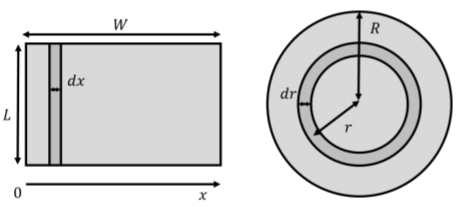
We proceed by modeling the plane as a disk made up of infinitesimal rings. Our infinitesimal charge, dq, is thus the charge on a ring of radius r and thickness dr, as illustrated in Figure \PageIndex{11}.
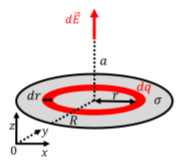
We know from Example 16.3.2 that the magnitude of the electric field a distance a from the center of the ring, along its axis of symmetry (the z axis in Figure \PageIndex{11}), is given by:
\begin{aligned} dE = kdq\frac{a}{(r^2+a^2)^\frac{3}{2}} \end{aligned}
By symmetry, for all of the different infinitesimal rings that make up the disk, the field will always point along the z axis. In order to determine the total field, we sum (integrate) the values of dE, over all of the rings, from a radius of r=0 to a radius r=R. For each ring, the value of r will be different, so we need to express dq in terms of dr in order to perform the integral. We know that the plane has a uniform charge per unit area given by \sigma. The charge dq of an infinitesimal ring is given by:
\begin{aligned} dq = \sigma dA=\sigma 2\pi r dr\end{aligned}
where dA=2\pi r dr is the area of the infinitesimal ring of radius r and thickness dr (think of unfolding the ring into a rectangle of height dr and length 2\pi r, the circumference of the circle, in order to determine the area). We now have all of the ingredients in order to determine the total electric field:
\begin{aligned} E &= \int dE = \int_0^R kdq\frac{a}{(r^2+a^2)^\frac{3}{2}} = 2\pi k a \sigma \int_0^R \frac{r}{(r^2+a^2)^\frac{3}{2}}dr\\[4pt] &=2\pi k a \sigma \left[ \frac{-1}{\sqrt{r^2+a^2}}\right]_0^R=2\pi k \sigma\left(1-\frac{a}{R^2+a^2} \right)\end{aligned}
Finally, we can take the limit of R\to\infty in order to get the electric field above an infinite plane:
\begin{aligned} E=\lim_{R\to\infty}2\pi k \sigma\left(1-\frac{a}{R^2+a^2} \right)=2\pi k\sigma=\frac{\sigma}{2\epsilon_0}\end{aligned}
where we used \epsilon_0 in the last equality as the result is a little cleaner without the factors of \pi. Note that for an infinite plane of charge, the electric field does not depend on the distance (our variable a) from the plane!
Discussion
In this example, we showed how we can model a two-dimensional charge distribution as the sum of one-dimensional charge distributions. In particular, we showed that an infinite plane of charge can be modeled as the sum of many lines charges or of many rings of charge (we chose the latter in the above). We also found that the electric field above an infinite plane of charge does not depend on the distance from the plane; that is, the electric field is constant above an infinite plane of charge.
josh's thoughts
A common source of confusion is the process of solving for the electric field produced by continuous charges. Point charges are well defined in space as being entirely contained within a single point, while continuous charges are objects which occupy 1, 2, or 3 dimensions. The electric field produced by point charges are easily modeled by \vec E = \frac{kQ}{r^2}\hat r, but the electric fields produced by continuous charges must usually be obtained from an integral.
When a charge is distributed, the charge on the object must be broken down into many small charges which are written as dq. From there, dq is rewritten in terms of a position variable over which it is convenient to integrate. Think of the position variable as a variable that you can use to distinguish charges, dq, located at different positions along the object.
For example, referring to Figure \PageIndex{12}, if I wanted to determine E at the top of a rod (left-hand panel), it would be most convenient for me to integrate over x, but if I wanted to determine E on the side of a rod, it would be most convenient to integrate over \theta.
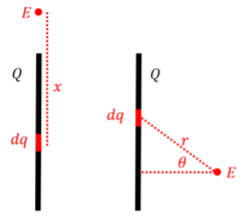
In order to determine the bounds of the integral, think of the range in position variable that is required in order to cover the entire object. I recommend paying close attention to Examples 16.3.2, 16.3.3, and 16.3.4, and attempting questions which require integration on the Question Library.

